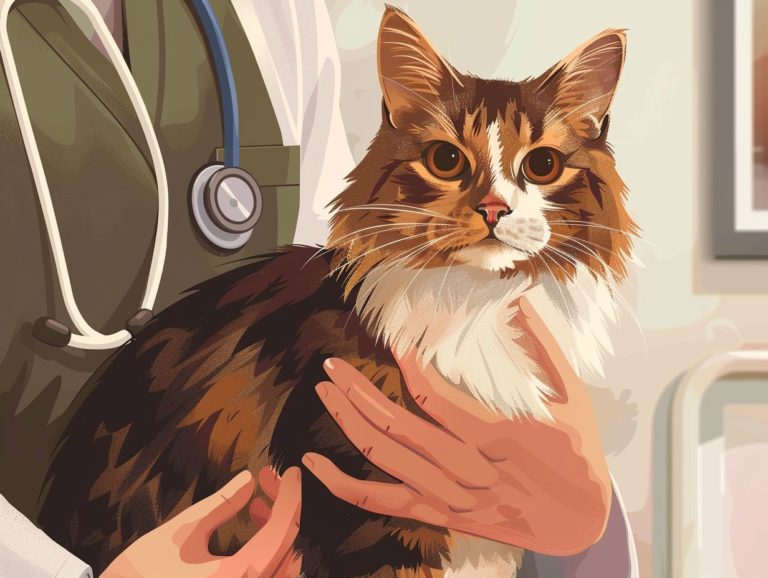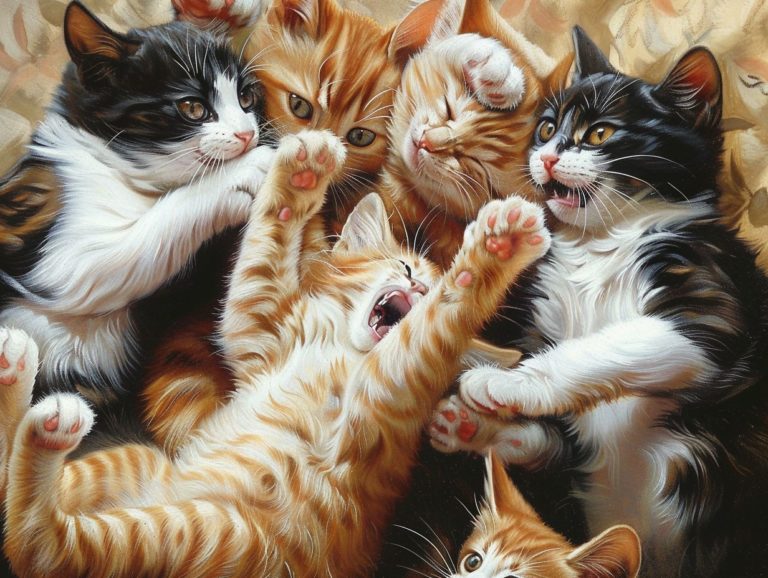Common Loopholes In Cat Health Insurance Policies
Cat health insurance plays a crucial role in maintaining your cat’s well-being, but challenges and loopholes may arise with these policies. When purchasing cat health insurance, it is essential to consider the types of coverage available, common loopholes, and methods to avoid them.
From pre-existing conditions to age restrictions and coverage limits, there are several factors to evaluate when selecting the best plan for your cat. This article delves into the following topics concerning cat health insurance:
- Types of coverage
- Common loopholes
- Strategies to prevent falling into these loopholes
Key Takeaways:
Understanding Cat Health Insurance Policies
Understanding Cat Health Insurance Policies is crucial for pet owners seeking to protect their cats from unexpected veterinary expenses. Cat health insurance encompasses a wide range of conditions, accidents, and diseases that cats may face at any stage of their lives.
From routine check-ups to complex surgeries or treatments for chronic ailments like diabetes or cancer, cat health insurance serves as a financial safety net for pet owners, covering expenses related to hospitalizations, diagnostic tests, and medications.
Most policies come with certain exclusions, such as pre-existing conditions, behavioral issues, and elective procedures like declawing. The reimbursement process varies among policies, with some providing direct payment to the veterinarian and others requiring the policyholder to pay upfront and then submit a claim for reimbursement.
Deductibles and age limits also impact coverage eligibility, with certain breeds or older cats potentially facing higher premiums.
What is Cat Health Insurance?
Cat Health Insurance provides coverage for accidents, illnesses, wellness care, and veterinary services for cats, offering reimbursement to pet owners for unexpected medical expenses and ensuring timely and appropriate medical treatment for their feline companions.
The coverage spectrum of cat health insurance is extensive, including reimbursement for emergency treatments, surgery, diagnostic tests, medications, and specialized treatments like chemotherapy or chronic disease management. It may also cover routine wellness care such as vaccinations, annual check-ups, and preventive treatments.
By investing in cat health insurance, pet owners can protect their pets and alleviate the financial strain of costly medical procedures, guaranteeing that their cats receive the best possible medical care.
Types of Coverage
Cat health insurance typically includes coverage for accidents, illnesses, wellness, vaccinations, and dental care. Understanding the different categories of coverage can assist cat owners in selecting the most suitable policy for their feline companions.
Accident coverage safeguards cats against unexpected injuries or emergencies by covering the expenses of necessary treatment. Illness coverage addresses a range of health conditions and diseases that may impact the owner’s pet. Wellness plans encompass routine and preventive care, such as check-ups, vaccinations, and screenings.
Some insurance plans also provide coverage for dental care, crucial for maintaining optimal oral health. These comprehensive coverage options enable cat owners to provide their feline friends with access to top-quality medical care.
Common Loopholes in Cat Health Insurance Policies
Pet owners should be aware of common loopholes in Cat Health Insurance Policies to avoid potential financial burdens. These loopholes may include pre-existing conditions, age restrictions, breed-specific exclusions, and limitations on certain treatments. It is important to note that coverage for certain illnesses or conditions in a cat health insurance plan does not guarantee full coverage. Some plans may restrict coverage for breeds predisposed to specific medical conditions, requiring owners to bear the cost of related surgeries. Similarly, treatments like chemotherapy or specialized procedures may not be fully covered, necessitating owners to cover a significant portion of the expenses. Understanding these potential coverage gaps is crucial when selecting a cat health insurance plan.
Pre-Existing Conditions
The most common exclusion in Cat Health Insurance Policies is pre-existing conditions, wherein insurers do not provide coverage for ailments that existed before the policy was initiated. Policyholders need to understand how their insurer defines and addresses pre-existing conditions for treatment and reimbursement options.
Pets with pre-existing conditions often encounter coverage limitations, as their insurance policies may exclude treatments for these existing conditions, leaving cat owners responsible for covering the entire cost of caring for their pet’s health issues. Reimbursement procedures for pre-existing conditions can be complex and may necessitate detailed documentation and evidence that the animal was not diagnosed or exhibiting clinical signs of the condition before the policy waiting period ended.
Therefore, it is crucial for pet owners to carefully review and comprehend their insurance policy, specifically how pre-existing conditions are defined and managed.
Age Restrictions
Age restrictions in Cat Health Insurance Policies often result in reduced access and coverage of medical treatment options for older cats, particularly for more advanced treatments and surgeries. Pet owners should be aware of how age restrictions affect coverage for older cats when selecting a health insurance policy for their pet.
Common ways in which age restrictions impact coverage for older cats include limitations on coverage for pre-existing conditions and elective surgeries. Older cats may face challenges in obtaining full coverage for medical care due to restrictions on pre-existing conditions, which are more prevalent in senior cats and may encompass chronic diseases like kidney failure, diabetes, or arthritis. This limitation can hinder an ill or aging cat’s ability to receive medical care without the owner shouldering a significant portion of the treatment cost.
Additionally, certain surgeries and procedures considered elective or non-essential for senior cats may not be covered, restricting access to specialized care for older felines.
Exclusions for Certain Breeds
Some Cat Health Insurance Policies have exclusions for specific breeds due to genetic predispositions or higher risks of certain medical conditions. It is important for the policyholder to be aware of these breed-specific exclusions if they own cats of those particular breeds.
These exclusions are implemented because certain cat breeds are more prone to developing hereditary conditions or health issues compared to others. For instance, breeds like Siamese and Maine Coon cats are often excluded from coverage due to their susceptibility to heart disease or kidney problems.
Pet insurance providers take these factors into account to evaluate the increased likelihood of breed-specific medical expenses and determine coverage options and policy terms accordingly.
Waiting Periods
Waiting periods are standard components of Cat Health Insurance Policies. They refer to the period of time between enrolling in a pet insurance policy and when the coverage becomes effective for accidents, injuries, or illnesses.
Waiting periods play a crucial role for policyholders seeking immediate coverage for their cats and can vary depending on the insurance provider and the specific policy chosen. Typically lasting from a few days to a few weeks, this waiting period means that any new conditions or incidents may not be covered during this time.
Furthermore, pre-existing conditions are generally excluded from coverage after the waiting period expires. The waiting period serves as a buffer for insurance companies against immediate claims for conditions that existed before the policy was initiated.
Coverage Limits
In Cat Health Insurance Policies, coverage limits refer to the maximum amount that insurance companies will contribute towards medical expenses, encompassing reimbursements, deductibles, and preventive care services. These limits serve to inform pet owners about their financial responsibilities and are crucial in determining the extent of financial assistance provided by the insurance policy. Understanding these limits helps cat owners anticipate potential out-of-pocket expenses and make informed decisions regarding their pets’ healthcare needs.
The coverage limits directly impact the reimbursement amount for veterinary visits, medications, surgeries, and other medical treatments. Typically, deductibles are linked to coverage limits, influencing the out-of-pocket payment required from the policyholder before the insurance coverage kicks in.
How to Avoid Loopholes in Cat Health Insurance
To avoid loopholes in Cat Health Insurance Policies, careful policy selection is essential, taking into consideration coverage limits, exclusions, administrative costs, deductibles, wellness coverage, and planning for final expenses. Pet owners can navigate these challenges by selecting the most appropriate policy for their cats, considering the following factors.
- When choosing a policy, it is crucial to review coverage limits and exclusions to ensure that the coverage aligns with your cat’s needs.
- Be aware of any waiting periods or pre-existing condition clauses that may affect coverage.
- Understanding the administrative costs associated with the policy is important as they can impact overall affordability.
- Therefore, it is crucial to comprehend the deductible structure to determine the out-of-pocket expenses that need to be paid before the insurance coverage kicks in.
- Wellness coverage benefits can be included to help cover routine veterinary expenses.
- Planning for final expenses in advance can provide peace of mind during a challenging time.
Reading the Fine Print
Analyzing the details of Cat Health Insurance Policies provides detailed information on how reimbursements are calculated, which deductibles apply, and whether preventive care services are covered. This information helps pet owners select the most comprehensive coverage for their cats.
Choosing the Right Policy
When selecting the right Cat Health Insurance Policy, it is important to compare providers, policy features, reimbursements, deductibles, and explore alternative coverage options. Pet owners should assess multiple policies to find the most suitable option for their cat’s medical requirements.
Evaluating providers based on their reputation, customer service, and financial stability is crucial. Key policy features to consider include coverage for accidents, illnesses, preventive care, and hereditary conditions. Understanding the reimbursement structure is essential for managing out-of-pocket expenses.
Deductibles significantly impact upfront costs, so striking a balance between premiums and deductibles is key. Exploring alternative coverage options like wellness plans or accident-only policies can offer additional layers of protection for your feline companion.
Frequently Asked Questions
What are common loopholes in cat health insurance policies?
Some common loopholes in cat health insurance policies include pre-existing condition exclusions, waiting periods for coverage, breed-specific exclusions, and coverage limits.
Can pre-existing conditions be covered by cat health insurance policies?
It depends on the policy. Some policies may cover pre-existing conditions after a certain waiting period, while others may completely exclude coverage for pre-existing conditions. It is important to carefully review the policy before purchasing.
Are there any waiting periods for coverage in cat health insurance policies?
Yes, many cat health insurance policies have waiting periods before coverage begins. This means that any illnesses or conditions that occur during the waiting period will not be covered. Waiting periods can range from a few days to several months.
Do cat health insurance policies have breed-specific exclusions?
Some policies may have breed-specific exclusions, meaning that certain breeds of cats may not be covered for certain conditions or illnesses. This is because some breeds are more prone to certain health issues. It is important to check if your cat’s breed is excluded before purchasing a policy.
Are there any coverage limits in cat health insurance policies?
Yes, most cat health insurance policies have coverage limits, meaning that they will only pay up to a certain amount for each condition or illness. Once the limit is reached, the policyholder will be responsible for any additional costs. It is important to review these limits carefully before choosing a policy.
Are there any other potential loopholes in cat health insurance policies?
Yes, there may be other loopholes or limitations in cat health insurance policies, such as age restrictions, exclusions for certain treatments or medications, and limitations on coverage for hereditary or congenital conditions. It is important to thoroughly read and understand the policy before purchasing to avoid any surprises in coverage.



